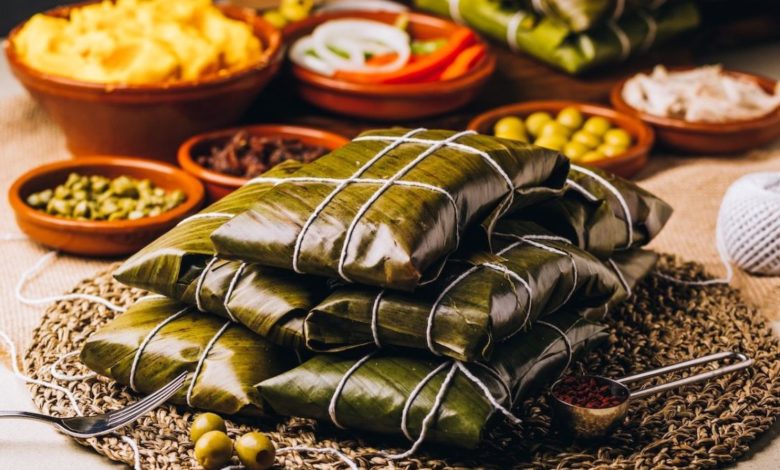Why enjoy tamales for the feast of February 2?
¿Por qué comemos tamales el Día de la Candelaria?

February 2 is the liturgical celebration of the event we hear of in Luke, Chapter 2: “When the days were completed for their purification according to the law of Moses, [Mary and Joseph] took [Baby Jesus] up to Jerusalem to present him to the Lord.”
The Feast of the Presentation is known as another Epiphany, since the prophecy and blessing of Simeon and Anna reveal Christ as the Messiah, in the same way that the gifts of the Three Kings pointed to his divinity and lordship.
The link to the Epiphany is made especially tangible in Mexico and parts of Latin America, since February 2 is as a second chapter of January 6, or Three Kings Day.
On January 6, the feast of Epiphany or Three Kings Day, families gather in the evening to enjoy a traditional sweet bread called the Rosca de Reyes (or bread of the kings, named for the ringed shape of the bread). Hidden within the rosca is a tiny figurine of the infant Jesus. As the rosca is sliced and distributed to each member of the family (and friends who’ve come for the celebration), everyone waits to see who has gotten the slice with the Jesus figurine hidden inside. The lucky winner is traditionally the one responsible for providing tamales — on February 2, when the group will convene again. But as well, he or she is entrusted with the responsibility of “presenting Jesus in the temple” this day.
In addition to the creche, many families have a larger-sized figure of Jesus as part of their Christmas decorations. (The children of the family will rock this image of Baby Jesus and sing lullabies to him in one of the most tender moments of Christmas Eve festivities.) This same figurine is now brought to church for a blessing, but his swaddling clothes are covered over by all manner of fine robes and raiment.
And sometimes — and here we see highlighted both the blessing and the danger in so-called popular religiosity — Jesus’ garments reflect not his kingship, but something more commonplace.
A family with a sick or disabled child might present el Niño Dios (the Child-God) dressed as a doctor. Others might present him with the tilma of Juan Diego showing Our Lady of Guadalupe. More profanely, Jesus is also sometimes presented in a soccer uniform. One catechist quipped that it was a sin to present Jesus this way, but a graver sin to present him dressed in the uniform of Cruz Azul (one of the many popular national teams).
While there may be elements of the celebration that have rather strayed from the significance and mystery of the feast, still it seems to be a case of precisely what Paul VI noted when he said that popular religiosity could reflect an “acute awareness of profound attributes of God” such as his “loving and constant presence.”
And what’s not to relish about an occasion to enjoy tamales?
Español:
Si te salió el muñequito (Niño Dios) en la Rosca de Reyes, seguramente estás alistando el pago de los tamales para el Día de la Candelaria, y preparándote para disfrutar de la tradicional tamaliza. Sin embargo, ¿sabes qué significa la celebración y por qué pagas con tamales si sacaste el muñequito y no con otro platillo?
La fiesta de La Candelaria es un rito católico que comienza en la Navidad, con el nacimiento de Jesús. Muchas familias mexicanas colocaron un Nacimiento en su hogar durante las fiestas decembrinas y comieron Rosca el 6 de enero, en un acto simbólico para recordar el día en que Melchor, Gaspar y Baltazar (los Tres Reyes Magos) ofrecieron oro, mirra e incienso al recién nacido niño Jesús.
Aquellos que en su deliciosa rebanada sacaron al “muñequito” se convierten en los “padrinos del Niño” y tienen que ofrendar tamales el 2 de febrero, día en que según la tradición se “levanta” al Niño Dios del pesebre para “vestirlo” y continuar con la ruta católica que pasa por los Carnavales que se festejarán en marzo, la Cuaresma y el Miércoles de Ceniza, hasta terminar con la Semana Santa.
Todavía en los mercados o en las zonas más tradicionales de México, hay lugares donde “visten” a los Niños Dios como parte de esta fiesta popular. El primer año lo visten de blanco, sin corona ni trono. El segundo ya puede llevar un traje de color y es hasta el tercer año cuando lo visten como Rey, como el Emperador del Universo, y le colocan su corona y su trono porque ya puede realizar milagros.
Comer tamales en esta fecha es un capricho gastronómico. Similar a casi todas las fiestas mexicanas, La Candelaria es una mezcla de tradiciones prehispánicas y católicas. Así como se festeja la presentación de Jesús al Templo de Jerusalén, nuestros antepasados conmemoraban el primer día del año azteca en honor a Tláloc, Chalchiuhtlicue y Quetzalcóatl.
Los tamales siempre estuvieron presentes en las ofrendas a los dioses, sobre todo porque están hechos de maíz, el material que los dioses utilizaron para crear al hombre. ¿Recuerdas la leyenda del Popol Vuh, el libro sagrado de los mayas? Bueno, pues éste cuenta que después de varios intentos fracasados por parte de los númenes por crear al hombre con distintos materiales, fue el maíz el que finalmente les permitió darle vida.
México Desconocido





